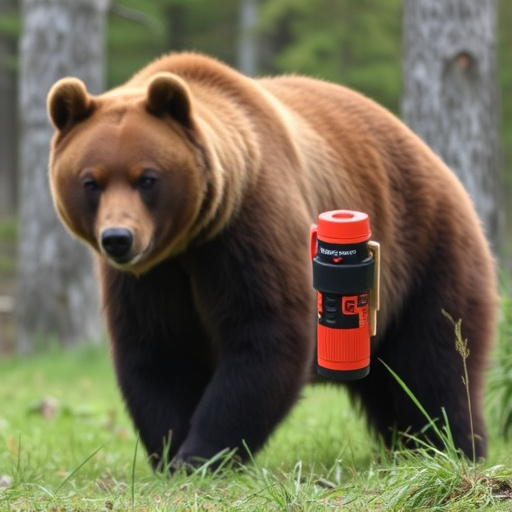Using bear spray as a last resort in bear country involves aiming at sensitive areas like eyes and nose from a distance of 20-30 feet to create a thick mist barrier. This range ensures coverage while minimizing wind interference. Opting for wide reach, fine mist distribution enhances contact with the predator's face. Swift action, proper aiming, and practice maximize effectiveness in deterring threats.
Bear encounters can be frightening, but understanding bear spray mechanics offers valuable self-defense. This article guides you through the essentials of bear spray as a safety tool in wild environments. We’ll explore how to choose the right bear spray tailored to your needs and navigate the nuances of spraying technique and timing for maximum effectiveness. Learn about the ideal distance and patterns for optimal protection, ensuring you’re prepared when facing potential predators.
- Understanding Bear Spray Mechanics and Effectiveness
- Choosing the Right Bear Spray for Your Needs
- Optimal Spraying Technique and Timing
- Effective Range and Patterns for Maximum Protection
Understanding Bear Spray Mechanics and Effectiveness
Bear spray is a popular defense mechanism for individuals venturing into bear country, but understanding its mechanics and effectiveness is crucial. When used correctly, bear spray can create a protective barrier between you and an attacking predator by temporarily blinding and disorienting them. The best bear spray distance pattern varies depending on the brand and type of spray, but generally, it’s effective up to 30 feet (9 meters).
The key to success with bear spray is aiming correctly and applying enough pressure to create a thick mist that covers your body. It’s important to remember that bear spray is not a guaranteed solution; it’s one tool in your survival kit. Factors like wind direction, terrain, and the size of the bear can impact its effectiveness. Always follow safety guidelines, stay calm, and be prepared to deploy bear spray as a last line of defense if confronted by a predatory bear.
Choosing the Right Bear Spray for Your Needs
When selecting bear spray, understanding the best distance and pattern is key for effective defense. The optimal range for a successful spray deployment varies based on factors like the bear’s behavior and your familiarity with the product. Typically, professionals recommend a range of 20 to 30 feet (6 to 9 meters), as this allows for sufficient coverage while minimizing the risk of wind or other environmental factors altering the spray pattern.
Choosing a bear spray with a wide reach can provide extra peace of mind in unpredictable situations. Look for models designed to emit a fine mist that spreads widely, ensuring maximum contact with the bear’s face and eyes, which are sensitive areas. The best bear spray distance pattern should create a barrier that gives you time to retreat or deter an attack, making it crucial to consider both range and effectiveness when selecting your defense tool.
Optimal Spraying Technique and Timing
When using bear spray as a defense, understanding the optimal spraying technique and timing is crucial. The best bear spray distance pattern typically ranges from 20 to 30 feet (6 to 9 meters), ensuring the spray reaches the predator’s face while maintaining safety. Aiming for the eyes, nose, and mouth area is highly effective, as these are sensitive zones that can temporarily disable or even incapacitate the animal.
Timing plays a significant role; using bear spray at the first sign of aggression or when the predator makes a charge is ideal. It’s essential to act swiftly but remain calm, allowing for accurate application. Practice and familiarization with the spray mechanism can help individuals respond instinctively during encounters, increasing their chances of deterring potential predators effectively.
Effective Range and Patterns for Maximum Protection
The effectiveness of bear spray in defending against predators largely depends on the distance and pattern of its application. The best bear spray distance is typically considered to be between 20 to 30 feet (6 to 9 meters), where the aerosol can reach and create a protective barrier effectively.
To achieve maximum protection, it’s crucial to follow specific spraying patterns. Aim high, targeting the predator’s face and eyes first, as this area has numerous sensory receptors. Move in a sweeping motion, covering your back and sides, creating a cone-shaped cloud that blocks the animal’s escape routes. Practice and preparation are key; familiarizing yourself with the spray’s pattern and range during training sessions before encountering a potential threat is essential for successful deployment.
Bear spray is a valuable tool for defending against predators, but understanding its mechanics and proper usage is key. By choosing the right bear spray tailored to your specific needs, mastering the optimal spraying technique, and knowing the effective range and patterns, you can ensure maximum protection in potential encounters. Remember, practicing and being prepared are essential when venturing into areas known for bear activity. With the right knowledge and equipment, like understanding the best bear spray distance and pattern, you can confidently navigate these wild environments with added peace of mind.
